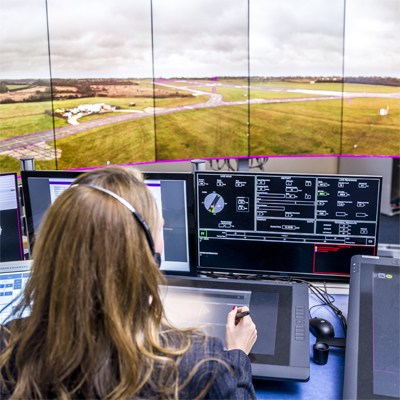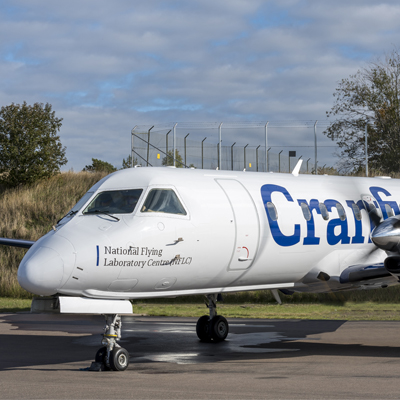The future of flight: sustainability, emerging technology and the post-Covid recovery – what will aerospace look like in the future?
The aerospace and aviation sector faces a period of great challenges and uncertainty – with many wondering what the future of the industry might look like in the aftermath of Covid-19 and under the increased pressure to hit carbon emissions targets to protect our environment.
As part of our Aerospace and aviation week in November 2020 a panel of industry experts and faculty members participated in a webinar, sharing their insights in to where aerospace might be in 25 years’ time. So what will the aircraft, airspace, airports and airlines of the future look like – and what research is Cranfield facilitating to get us there?
This first article in a five-part series looks at the aircraft of the future.
Aircraft: new architectures and concepts to improve sustainability and air mobility
It’s clear that in order to meet the demands of the challenges the sector faces, innovation is required across the board – including the aircraft we travel in. During the webinar, Chana Sais, MSc Thermal Power alumna and PhD researcher at Cranfield’s Propulsion Engineering Centre, highlighted that we have an aim of reducing carbon emissions by 50% by 2050, but the estimated demand growth for the industry is 4-5% per year – adding an additional challenge when it comes to meeting the ambitious carbon emission goal. Efficiency improvements in technology and infrastructure can give us a 1.5-2% reduction in emissions per year, but this still won’t be enough, and so alongside sustainable aviation fuels we also need to consider radical, new generation technologies such as new aircraft configurations and propulsion systems.
87% of aviation fuel consumed is by 100 plus passenger vehicles, so according to Chana the focus of technology development needs to be on commercial aviation. The challenge, she states, is that we need a combined effort from all aviation stakeholders, aircraft and engine manufacturers, airlines and certification authorities to facilitate this development.
Evolutionary technologies
Evolutionary aircraft technologies that offer the potential to help the industry reach climate neutral aviation in the next 25-30 years include:
- New aircraft architectures, with configurations such as blended-wing body or “flying V” crafts – a departure from the narrow-bodied vehicles we are familiar with.
- Innovations in propulsion engineering – such as boundary-lain ingestion, distributed propulsion, hybrid electric architectures and the use of hydrogen.
Not only do we need to develop new forms of aircraft - we also need to make airplane development more affordable, Dr David Paisley (PhD Aerodynamics 1982), Technical Fellow/Product Development, Boeing, stated during the webinar. We need to be able to develop new airplanes and concepts within manageable time frames and budgets. Dr Paisley also highlighted the importance of “trying everything”. When it comes to alternative fuels such as batteries, hydrogen or synthetic fuels, we need to understand where they apply and where they don’t. There can be a tendency to try and “pick the winners ahead of time” as David described it – suggesting that one of the key values we can provide is to try everything and pursue it until it really doesn’t work, because there are always unexpected applications of technologies.
Passenger experience
Passenger perception and acceptance of change will also play a key role in the adoption of the aircrafts of the future. The flight experience will be very different to flying in fixed wing aircraft or helicopters, says Chana, with the new lightweight designs, use of multiple rotors and flying at lower altitude leading to greater occurrences of turbulence. Furthermore, Chana suggests that the notion of flying in fully autonomous aircraft is currently something that many passengers still cannot fully accept. Therefore, to make the adoption of new technologies and concepts that will improve air mobility and address sustainability demands feasible, we need to mature passenger perception and acceptance over the next 25 years as well as working on the technology itself.
Realising our ambition
Cranfield is the only university in Europe with its own airport, aircraft, pilots and air navigation service provider.
Our Aerospace Integration Research Centre (AIRC) provides the facilities for new aerospace technologies to be developed and tested for new aircraft concepts. The unique focus on integration within the AIRC enables the development time from concept to implementation to be shortened, making use of visualisation screens, flight simulators and an air traffic management simulator. Flight simulators allow pilots to gauge the effects of new aircraft concepts on handling and safety, meanwhile a digital wind tunnel makes use of virtual reality goggles to visual aerodynamic flows to support the aerodynamic assessment of new designs.
Elsewhere on campus, the Integrated Vehicle Health Management (IVHM) Centre is working with industrial partners to deliver a “conscious aircraft” that is self-monitoring and self-learning. Projects include:
- Autonomous testing diagnostics and defect monitoring to optimise operational efficiency of aircraft and rotors.
- Prognostics Health Management (PHM)-based adaptive power management for hybrid-electric aircraft.
- PHM algorithms to monitor and predict failures and calculate remaining useful life, assisting with maintenance planning and providing high availability of new, more-electric aircraft systems.
Keep an eye out for the next article in our future of flight series, discussing innovations in how we manage our airspace to facilitate the adoption of new technologies.
Want to find out more right now? Head over to the alumni portal to watch the ‘Reimagining our aerospace sector in 25 years’ time’ webinar in full.
Learn more about Cranfield's campaign for a new flying classroom and laboratory.




